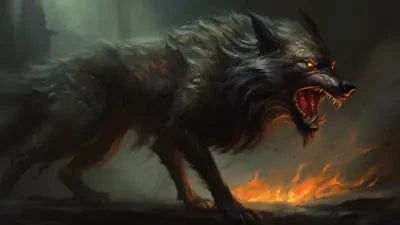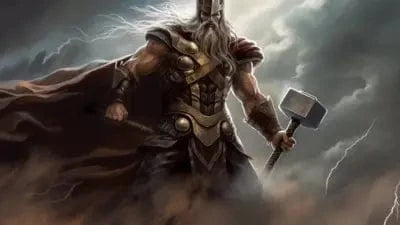As you know the Vikings were mainly warriors and seafarers, who lived in the harsh climatic conditions of Scandinavia, it is no wonder that the compass is such an important symbol of Icelandic culture. Today, we're going to shed some light on this absolutely essential symbol of Viking culture - the symbol of Vegvisir.

VEGVISIR ORIENTATION SYMBOL
Vegvisir takes its name from the combination of the Icelandic words vegur (road or path) and visir, the closest translation of which in this context is "guide". Its most basic meaning is that of signpost or guide. From this we can deduce the meaning of vegvisir - the runic compass.
But, how does the vegvisir compass work?
Well, it is used magically. It should not be confused with a real Viking compass.
Of course, as experienced sailors, the Vikings were used to travelling on open bodies of water, and to do this they had to use something to navigate. The first Viking compass was one of the most memorable Viking achievements that earned them the title "The first true navigators". Here we are not talking about that.
As we said, the vegvisir is an object of Norse magic. It is supposed to be worn by a person going through storms or bad weather.
How is the vegvisir symbol worn, you might ask?
Well, according to the Huld Manuscript, it is supposed to be drawn with blood on a person's forehead. Of course, few people today would engage in such a sacrifice for a bit of magical protection, but you have to look at the time context.
Before electricity, the internet and GPS, and all the modern inventions we use today to get home safely, people had to get creative. If they had to sculpt a vegvisir symbol to keep from getting lost, they did.
The meaning of the vegvisir hands is not entirely clear, but as there are eight of them, the most likely explanation is that they represent the points of the compass - the 9 worlds in Norse mythology. Each hand represents a world and the central part is Midgard the world of Men, the world we live in.

44,90€
WHAT IS THE PURPOSE OF VEGVISIR TODAY?
Since the origin of the symbol of vegvisir in the Huld manuscript, its purpose has changed. Today, many who use the symbol do not use it for its original purpose of indicating the way. Today, it is often used as one of the most recognisable symbols of Norse mythology and paganism in general (the irony is that it was created long after the pagan era).
One thing at least remains similar to the original use in Iceland. As we have already said, the vegvisir symbol was engraved on a forehead.
In fact, it was rarely found on someone's forehead, but quite often on the body. Yes, today, the vegvisir is often tattooed. It is one of the most common tattoos related to the Norsemen (apart from probably Mjolnir and Helm of Awe). Even the Icelandic singer Bjork has a vegvisir tattooed on her left arm.
To be honest, it's not such a bad idea for a tattoo. Who wouldn't love a symbol that is supposed to guide you through life? Of course, it's not about weathering storms or bad weather, but a more metaphorical meaning. Who doesn't need a little guidance in their life?
IS VEGVISIR REALLY VIKING?
Now, the main reason why we are here today.
The first thing that is important to mention is that thevegvisir does not date from the Viking era. The origin of the vegvisir comes from Icelandic grimoires. To clarify, the Icelandic grimoire is a book of spells and various things related to magic. One source is the Huld manuscript and the other is the Icelandic book Galdrabok.
Since the Huld manuscript dates from the 19th century and Galdabrok dates from the late 16th or early 19th century, it can be argued that Galdrabok is the earliest mention of the vegvisir symbol.
As we know, the Viking Age lasted until the 11th century, and since the first mention of the vegvisir symbol dates from the late 16th century, we can say with certainty that the vegvisir symbol appeared at least 500 years after the Viking Age (and probably a bit later).
VIKING SIGNIFICANCE: THE ESSENTIAL
So, now you know. When you see that someone has gotten a vegvisir tattoo, you have every right to ask about the true origin of the sign.
If the answer is ''oh, it's a Viking symbol, it's very cool'', it's not only your right, but also an obligation to correct him since the only part of that sentence that is correct is that it's very cool.
So, vegvisir is not a Viking symbol, it's an Icelandic symbol. It's not a symbol, it's amagical staff. At the end, score a touchdown by explaining that it's a compass, but not really a compass either. Maybe even ask them why they don't have it on their forehead.
If you just wanted to know more about Vegvisir, you can stop here, but to understand the role of symbols in different cultures, read on.
The Place of Symbols in Religions
Religious symbols have served a variety of purposes throughout history, but they have primarily served as a moral compass, constantly reminding people of their beliefs. Symbols also had the power to directly convey the word of God, to break spells, and to protect and guide in the darkest of times.
A single religious symbol often had opposite effects in itself, and therefore offered dual value to those who believed in it.
For example, the original purpose of the Star of David was to cast out evil spirits. Yet it eventually became the symbol of martyrdom and strength - the most widely recognised symbol of Judaism.
In Christianity, the symbol of the cross is seen as a sign of both suffering and salvation. And according to Chinese philosophical beliefs, the ancient symbol of Yin and Yang represents the opposing but complementary forces of life. And the writings of the Prose and Poetic Edda suggest that the symbols of Norse mythology were no different.
It is important to remember that a symbol is closely related to the society in which it appeared. Still, it has to be a term philosophically broad enough for us to apply it to our lives ten centuries later.
WHY ARE SYMBOLS IMPORTANT?
Some anthropologists argue that symbols are the universal marks representing specific ideas and objects according to the cultural context in which they appear. Others argue that they are so deeply embedded in our unconscious that there would be no intelligent life without them. But all agree that symbols have existed since the beginning of humanity.
Whether you believe it or not, symbols are and always have been, all around us.
Sometimes we notice them immediately, and sometimes they hide in plain sight, just waiting to get our attention. For example, even everyday objects such as a mirror, a handbag or a knife have their own symbolic meaning.
In the literature, we may find that a mirror represents vanity or a passage through the soul, that a purse is a universal symbol of wealth, and that the symbol of a knife usually represents betrayal.
Although the human mind responded to symbols more immediately before the scientific revolution, it goes without saying that they are still linked to all aspects of our lives.
Through colours, sounds, patterns and signs, symbols have forever shaped our worldview. Whether in medieval imagery or modern logos, they have remained a fundamental expression of meaning and ideas that are often worth a thousand words.
OTHER IMPORTANT SYMBOLS IN NORDIAN MYTHOLOGY
The Scandinavian peoples had many very important symbols, even their Alphabet the Futhark composed of rune was a powerful symbol catalogue.
And many more ...





